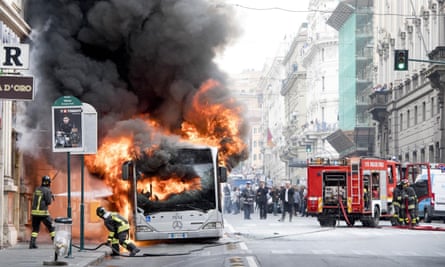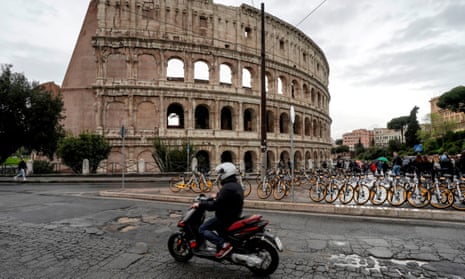It is 6am on a Sunday and the streets of the Ostiense neighbourhood in southern Rome are empty. The metro has just opened and nearby cafes still await their first customers.
Seven men and women are working hard, their faces obscured by scarves and hoodies as they unload bags of cement and sand from a car near the Basilica of St Paul Outside the Walls.
They are not criminals. Members of the secret Gap organisation, they hide their identities because what they are doing – fixing a broken pavement without official permission – is technically illegal.
City maintenance – or the lack of it – has long been a hot-button issue in Italy’s capital. There are an estimated 10,000 potholes in the city – a source of frustration for the many Romans who travel by scooter. Garbage collection has also become a major problem since the city’s landfill was closed in 2013, with periodic “waste crises” where trash piles up in the streets. Cases of exploding buses and the collapse of a metro escalator made international headlines.

The seven clandestine pavement-fixers are part of a network of about 20 activists quietly doing the work that the city authorities have failed to do. Gap stands for Gruppi Artigiani Pronto Intervento, (“groups of artisan emergency services”) but is also a tribute to the partisans of Gruppi di Azione Patriottica, who fought the fascists during the second world war.
“We chose this name because many of our parents or grandparents were partisans and we liked the idea of honouring their memory,” says one of the activists, a fiftysomething architect who goes by the pseudonym Renato. While the modern-day Gap aren’t risking their lives, their modus operandi is inspired by resistance saboteurs: they identify a target, strike and disappear unseen into the city streets.
Gap have been busy over the past few months. In December they repaired the fountain, built in the 1940s, of the Principe di Piemonte primary school. In January they painted a pedestrian crossing on a dangerous major road. Their latest work, the pavement fixing in Ostiense, involved filling a deep hole that regularly filled with water when it rained.

They always leave their signature, a logo of a hammer and screwdriver, either painted with stencils on the ground or on a piece of paper. They also leave leaflets exhorting their fellow Romans to follow their example: “The Gap are a secret organisation – instead of carrying out sabotage actions the gappisti make repairs where bureaucracy fails. Find your goal, organise and repair: become a gappista yourself!”
Peppe (another pseudonym) is one of the founding members. He came up with the idea, he says, because his child goes to the elementary school with the broken fountain. A few months ago, he recalls, city authorities came to fix it but only repaired the pipe, and left the structure as a whole unusable. “So we decided to intervene at night …”
Peppe says Gap have to break the occasional law. To repair the fountain they entered the school without permission, and to paint the pedestrian crossing they blocked a road without authorisation.
“True, we have bypassed the local government,” says Renato. “But in the case of the fountain nobody else was going to fix it for at least two years, so we said to ourselves: let’s do it and see what happens.”
Gap members insist their actions are not a reaction to the city government of mayor Virginia Raggi, of the populist Five Star Movement. “This situation is the result of many problems adding up through the years,” says Nadir, another pseudonymous Gap activist and architect. “All the parties that have ruled the city are responsible.”

Many Italian cities, including Rome, Naples and Turin, have faced significant budget cuts in recent years and are therefore struggling to fund city services. Critics might argue that citizen action like that of Gap could discourage the government from doing its job: why spend time and money to fix holes when there are residents doing it for free? But Gap members hope their intervention energises the local administration into action.
“It’s not like we’re a group of anarchists,” says Renato. “We’re just people living here in this neighbourhood where everyone knows each other, trying to make things better.”
After about an hour, the pavement is fixed and the group leave their logo engraved in the wet cement. As the street starts to fill with people going to work or walking dogs, the activists pack up their car and leave.
“I hope someone will follow our example,” says Nadir. “I would love to learn one day that Gap groups have formed in other cities.”
Follow Guardian Cities on Twitter, Facebook and Instagram to join the discussion, catch up on our best stories or sign up for our weekly newsletter

Comments (…)
Sign in or create your Guardian account to join the discussion